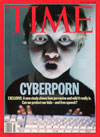This article was republished with permission from the 1995 blog.
The demotion last month of Brian Williams, the former NBC News lead anchor, was testimony, at least in part, to the power of social media to expose and debunk.
The New York Times made that point last week, saying the storm over Williams’ falsehoods — among other tall tales, he was accused of lying about his presence on an Army helicopter in 2003 that took fire in Iraq — “began with … Facebook comments, was amplified by Twitter and reached a crescendo as amateur sleuths took to YouTube to fact-check Mr. Williams’ reporting.”
Such unmaskings, the Times suggested, were far more difficult “before the Internet became ubiquitous.”
Well, maybe.
But memorable unmaskings there were in the mid-1990s, the time of the early Web, when just a fraction of the American adult population was online.
Indeed, a powerful demonstration of the Internet’s corrective power took place almost exactly 20 years ago, when the emergent online world was energized in condemning a wildly exaggerated cover story about “cyberporn” in the issue of Time magazine dated July 3, 1995.
As I note in my latest book, 1995: The Year the Future Began, the illustration on the newsmagazine’s cover was of “a pasty youth at a computer, his eyes bulging and his mouth agape in the apparent shock of confronting images of some unmentionable sex act. Inside the magazine, an illustration depicted a naked man in suggestive embrace with a computer.”
The Time report discussed what it said was “an exhaustive study of online porn” conducted by a “research team at Carnegie Mellon University” that drew on “elaborate computer records of online activity” and measured “for the first time what people actually download, rather than what they say they want to see.” The “Carnegie Mellon researchers discovered . . . an awful lot of porn online,” the cover story said—specifically that 83.5 percent of images stored at online Usenet newsgroups “were pornographic.”
The ABC News “Nightline” show also cited the study, in an episode about pornography online. “It’s the kind of smut many of the porn stores won’t even carry,” the program’s host, Ted Koppel, declared in introductory remarks.
As I note in 1995, such characterizations “lent an unmistakable impression that much of the Internet abounded in filth.” And they played to the designs of lawmakers such as U.S. Senator J. James Exon (D-Nebraska), who sought to regulate the Internet by outlawing online pornographic images that children could access. Exon’s efforts gave rise to the Communications Decency Act of 1996; the U.S. Supreme Court in 1997 struck down key provisions of the law as First Amendment violations.
But this time 20 years ago, Internet advocates and online discussion groups (such as The Well) were assailing Time’s “cyberporn” report, pointing out how alarmist and overblown it was — “a messy blend of exaggeration, thin research, and dubious analysis,” as I write in 1995, adding:
“What Time called the ‘Carnegie Mellon study’ was really the work of Marty Rimm, a thirty-year-old undergraduate student in Carnegie Mellon’s electrical and computer engineering program. … Critics pointed to the study’s ambiguous data and methodological shortcomings. … Moreover, the research was based largely on data extracted from private online bulletin boards that sold pornographic content to adults using credit cards, which meant they were not readily accessible by children.”
One implacable critic of Rimm’s work was Mike Godwin, then staff counsel for the Electronic Frontier Foundation, who likened the study to surveying adult bookstores at Times Square and applying the findings to describe merchandise at Barnes & Noble stores. Godwin dissected Time’s cover story in an online article titled “journoporn,” a memorable contribution to what then was called a “flame war.”
Confronted with a barrage of “flame war” critiques and complaints, Time backpedaled, acknowledging serious questions about the study’s methodology and how its data were gathered. In a climb-down article, Time cited management professors at Vanderbilt University who had read Rimm’s study and found the statistics “misleading or meaningless.”
Time was embarrassed, the study it relied on was repudiated, and Internet advocates had demonstrated in impressive fashion the online world’s capacity to challenge, to deflate, and to act as a swift and potent vetting mechanism.
All that in 1995 — a time when Brian Williams was being touted as heir apparent to the NBC Nightly News anchor, Tom Brokaw. Williams’ demotion last month sends him to MSNBC and the second-string of cable news.
W. Joseph Campbell, Ph.D., is a tenured full professor at American University’s School of Communication in Washington, DC. His new work, 1995: The Year the Future Began, is his sixth book.






